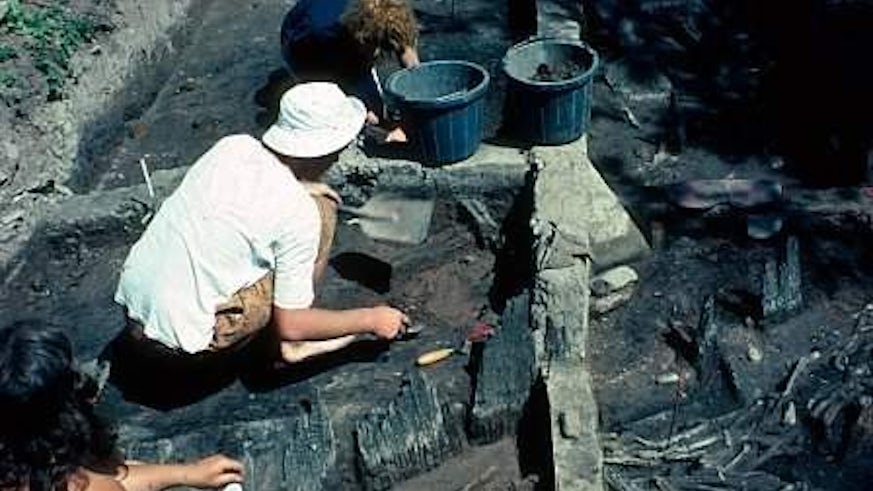The ancient Welsh lake that gave up its secrets
4 September 2020

‘Time capsule’ archaeological site reveals remarkable insight into Dark Age Wales, Viking clashes and Alfred the Great’s warrior daughter
A new book by the archaeologists who led the amazing excavation of Wales’ only crannog is revealing the turbulent history of a royal court on a mystical lake in the Brecon Beacons for a new generation.
Llangorse Crannog – the Excavation of a Royal Medieval Site in the Kingdom of Brycheiniog by Dr Alan Lane and Dr Mark Redknap follows the excavation led by the authors over five years from 1989 to 1994 and reprised in 2004.
Using latest scientific techniques, the archaeological team from Cardiff University and Amgueddfa Cymru - National Museum Wales uncovered and studied finds amounting to a time capsule into three decades of Dark Age Wales.
The crannog – an ancient fortified dwelling constructed in a lake or marsh - was first discovered just over 150 years ago, but unlike its many counterparts in Scotland and Ireland it remains the only known structure of its kind in Wales.
Senior Lecturer in Archaeology at the School of History, Archaeology and Religion, Dr Alan Lane said: “The realisation that the crannog could be closely dated and tied in with Aethelflaed’s destruction of the site makes this site quite unique in the British Isles”.
Dr Mark Redknap, Head of Collections and Research (History and Archaeology) at National Museum Wales said: “ The silk-embroidered garment is an incredibly rare find and may have been a gift from King Alfred’s court to the king and queen of the Welsh kingdom of Brycheiniog”.
Initially investigated in the 1860s by Victorian antiquarians Edgar and Henry Dumbleton but with few finds to verify dates, it would be 120 years before modern archaeology could firmly establish the construction of the wooden palace structure, finally showing its construction in the last decade of the life of Alfred the Great.
In a combined on and offshore investigation, the team of experts and archaeology students would discover far more than first anticipated.
In the first year, dendrochronological dating of submerged oak palisade planks placed construction in the early 890s. The research proved the spectacular royal court was indeed short lived: scientific study of wooden remains indicated the destruction of the site by fire, fitting with the capture of the site by an English army recorded in 916AD in the Anglo-Saxon Chronicle.
But more finds would reveal a tantalising glimpse of everyday life for the royalty living at the site and even a glimpse of Mercian queen Aethelflaed, Alfred’s great tactician daughter, now known to a modern generation as a key figure in the Netflix series The Last Kingdom .
Through painstaking surveys and excavation on land and underwater, the team unearthed a host of treasures, from clear evidence for manufacture and use of early medieval secular and religious metalwork to the largest depository of early medieval carpentry in Wales. As a royal seat, hunting and feasting was certainly part of life for some, with significant numbers of animal bones from the early medieval period suggesting entertainment on a royal scale.
The jewel in the crown remains a remarkable richly embroidered silk and linen textile, now fully analysed and placed in context in the new book. Although carbonised, it reveals a picture of elite life befitting the chronicles. The delicate nature of the textile suggests a high-status owner such as the Brecon queen who was taken hostage by the warrior queen of Wessex when the site was destroyed,.
In the intervening centuries, stories of a sunken landscape, by chronicler and archdeacon of Brecon Gerald of Wales in the twelfth century, would be superceded by folk tales of a palace destroyed by the wickedness of its inhabitants. While not reoccupied, the site would come to prominence again in Elizabethan times during a riotous dispute about property and fishing rights.
The excavations successfully took the story of the site back by at least seven millennia, through the discovery of flint tools from the Early Bronze Age as far as the Neolithic and Mesolithic.
Re-examining the early investigations, the publication not only describes both the anatomy of the crannog mound and its construction, and the material culture found, but also draws out cultural affinities, the kingdom’s relationships to origin myths, and to probable links with early medieval Ireland.
Llangorse Crannog – the Excavation of a Royal Medieval Site in the Kingdom of Brycheiniog by Alan Lane and Mark Redknap is published by Oxbow Books. The landmark book is published in the centenary of the founding of the first department of Archaeology in Wales by Sir Mortimer Wheeler.